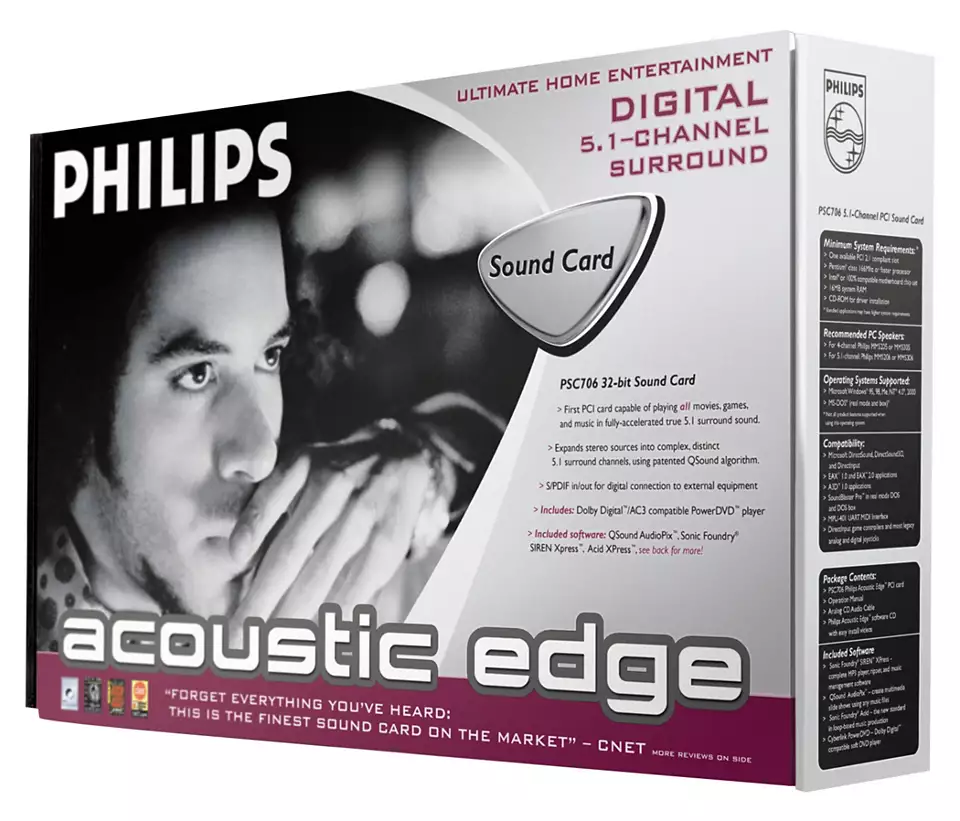 Philips
Philips
Philips, a household name across many electrical and electronic categories including televisions, monitors, multimedia devices and even games consoles! They also dabbled in sound cards for a short time in the early noughties. I am pretty sure they also released several desktop PCs in the early IBM clone era of the mid-80s.
All three of their 2002 'Edge' range got an upgrade at some point from their use of the SAA7780 ThunderBird to the VLSI-designed SAA7785 following Philips buyout of VLSI around that time.
Sound Cards / Wavetable Daughterboards
Rhythmic Edge (PSC-703)
The cheapest of the three PCI sound cards Philips launched in 2002, alongside the Seismic Edge and Acoustic Edge. All of these were PC sound cards that supported both FM synthesis and wavetable audio. Rhythmic Edge came with a 4-channel analogue output, S/PDIF digital output (stereo, AC3 or DTS signal), and a dual MIDI/game port. On the wavetable synthesis side of things it had a 576-voice ROM with reverb and chorus effects, all playable over 64 channels at 16-bit, 44.1 kHz. The DSP came with QSound 3D positional audio (courtesy of QSound Labs) for 2 or 4 speakers, with environmental modelling for EAX and DirectSound3D. Interestingly, the card also supports A3D (Aureal 3D) 1.0 applications. The game/MIDI port is MPU-401 compatible. Flyer |
Seismic Edge (PSC-705)
The middle-of-the-pack of the three PCI sound cards Philips launched in 2002, alongside the Rhythmic Edge (cheapest) and Acoustic Edge (top-end). All of these were PC sound cards that supported both FM synthesis and wavetable audio. Seismic Edge added 5.1 channel output over Rhythmic Edge's 4 channels. Aside from that, it kept the same specs as Rhythmic Edge, which included S/PDIF digital output (stereo, AC3 or DTS signal), and a dual MIDI/game port. On the wavetable synthesis side of things it had the same 576-voice ROM with reverb and chorus effects, all playable over 64 channels at 16-bit, 44.1 kHz. The DSP [also the same as PSC-703] came with QSound 3D positional audio (courtesy of QSound Labs) for 2 or 4 speakers, with environmental modelling for EAX and DirectSound3D. The card also supports A3D (Aureal 3D) 1.0 applications. The game/MIDI port is MPU-401 compatible. |
Acoustic Edge (PSC-706)
The premium choice of the three PCI sound cards Philips launched in 2002, alongside the Rhythmic Edge (cheapest) and Seismic Edge (middling). It is unclear from my findings whether Acoustic Edge was the amalgam of Dynamic Edge 4.1 (with quad surround), and Sonic Edge 5.1 (with 5.1 surround), from this white paper from 2002. The only thing I can tell is that Acoustic Edge had active audio enhancements called QSizzle and QRumble. |


